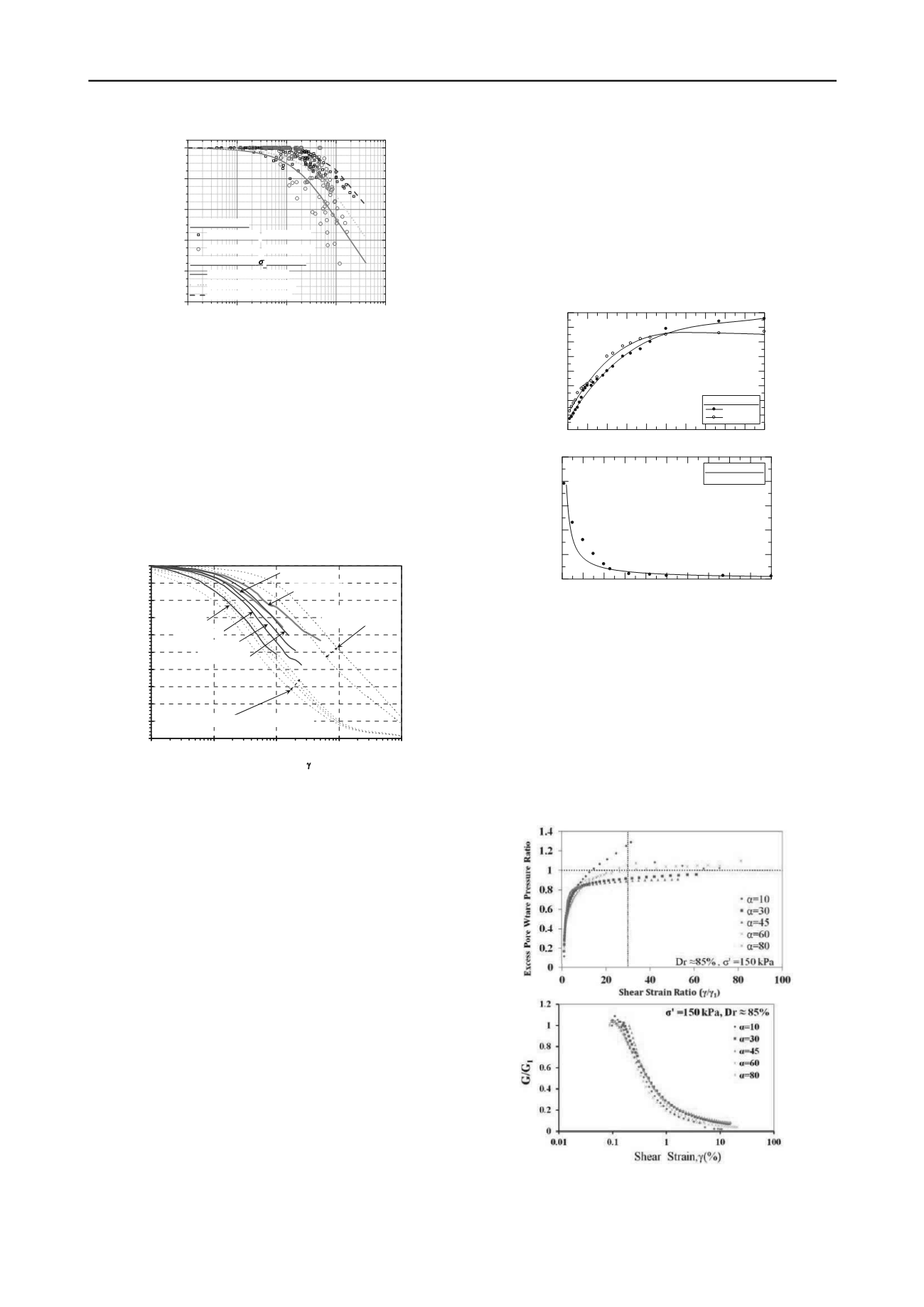
1400
Proceedings of the 18
th
International Conference on Soil Mechanics and Geotechnical Engineering, Paris 2013
10
-4
10
-3
10
-2
10
-1
1
0.0
0.2
0.4
0.6
0.8
1.0
ACL (this study)
Location #1 (
0
~ 11 - 89 kPa)
Location #2 (
0
~ 11 - 106 kPa)
Zekkos et al. 2008 (
0
< 125 kPa)
100% material < 20 mm
62-76% material < 20 mm
8-25% material < 20 mm
G
/
G
max
Shearing Strain (%)
Figure 2. Modulus reduction curves of MSW (
Zekkos et al.
).
The paper by
Liao et al.
(USA) provides very useful
laboratory test data on the ‘Normalized shear modulus of
compacted gravel’ used for fills. Resonant Column and
Torsional Shear (RCTS) tests were performed on large diameter
specimens of poorly graded (PA) gravel and well-graded (WA)
sandy gravel, both scalped at 19 mm particle size. The curves
for the WA and PA samples (Fig. 3) fall in the ranges suggested
by Seed et al. (1986) and Rollins et al. (1998) respectively, and
are quite consistent with the stress-dependent curves suggested
by Menq (2003) on the basis of the modified hyperbolic model
formulated by Darendeli (2001). Once again, it is expected that
similar considerations about the dependency on grading and
stress state would hold for the damping-strain curves.
0.0
0.1
0.2
0.3
0.4
0.5
0.6
0.7
0.8
0.9
1.0
0.0001
0.001
0.01
0.1
1
Cyclic Shear Strain,
(%)
G/G
max
52, 207, 414, 827 kPa; C
u
= 150 (Menq, 2003)
WA (414 kPa)
PA (52 kPa)
WA (52 kPa)
WA (207 kPa)
WA (827 kPa)
PA (207 kPa)
52, 207 kPa; C
u
= 2.1
(Menq, 2003)
Figure 3. Modulus reduction curves of compacted gravels (
Liao et al.
)
.
Ray & Szilvágyi
(Hungary), authors of the paper ‘Measuring
and modeling the dynamic behavior of Danube Sands’, report
and discuss results obtained by a RCTS device on hollow
pluviated specimens of a typical alluvial sand. The equipment,
originally developed by the first author in USA (Ray & Woods,
1987), was updated in Győr University in order to be capable of
loading at higher torques and measuring wider strain ranges,
under non-isotropic confining stresses and irregular cyclic shear
loads. The Authors mention, although not showing the
comparisons, that such data were satisfactorily interpreted by
the Ramberg-Osgood model with extended Masing criteria.
Sas et al
(Poland) investigate ‘The behaviour of natural
cohesive soils under dynamic excitations’, by RC tests on
natural shallow samples of silty sand, subjected to stepwise
consolidation stages. The normalized shear modulus-strain
curves, however, appear excessively non-linear for some of the
confining stress levels: this may be due to several experimental
factors, including strain measurement resolution and/or effects
of the consolidation procedure followed.
3 MEASUREMENT AND MODELLING OF CYCLIC
DEGRADATION, STRENGTH AND LIQUEFACTION
3.1
Clean sands
Bolouri Bazaz & Bolouri Bazaz
(Iran) present ‘An experimental
approach to evaluate shear modulus and damping ratio of
granular material’, a Standard Leighton Buzzard sand. Loose
and dense dry specimens were prepared by air-pluviation in a
cubic Biaxial Testing (BT) device, able to apply independent
variations of horizontal principal stresses by hydraulic actuators.
Repeated sequences of cyclic loads with increasing peak stress
ratios, R
max
, showed that both dense and loose sand underwent
progressive densification with the number of cycles. The stress-
strain behaviour was featured by a kind of ‘elastic shakedown’,
i.e. closed loops corresponding to steady shear modulus and
damping ratio approaching zero (Fig. 4). At the highest stress
ratio, soil behaviour turned to softening and dilatant, eventually
leading to a ‘run away’ failure. The results encourage to an
interpretation in terms of hardening plasticity models.
0 10 20 30 40 50 60 70 80 90 100
No. of cycles
0
10
20
30
40
50
60
70
80
Shear modulus (GPa)
Test No.: D-290
R =4
R =4.33
max
max
0 10 20 30 40 50 60 70 80 90 100
No. of cycles
0
10
20
30
40
50
Damping ratio (%)
Test No.: D-290
R = 4
max
Figure 4. Cyclic evolution of modulus and damping for dry dense sand
(
Bazaz et al.
).
A further interesting contribution from Iran is by
Jafarzadeh
& Zamanian
, investigating the ‘Effect of stress anisotropy on
cyclic behavior of dense sand with dynamic Hollow Cylinder
apparatus’ (HC). Wet tamped specimens of uniform Babolsar
sand were saturated and isotropically consolidated at the same
effective stress, then subjected to constant amplitude shear loads
corresponding to different ratios between torsional shear and
deviator stress, i.e. to different degrees of stress-induced
anisotropy. Results show that the angle
, representing stress
anisotropy, does affect the excess pore water pressure ratio (Fig.
5a), but has no significant influence on the strain dependency of
shear modulus (Fig. 5b) and damping ratio.
(a)
(b)
Figure 5. Effects of stress anisotropy on pore water pressure (a) and
shear modulus (b) for saturated dense sand (
Jafarzadeh & Zamanian
).
Another study on the effects of loading pattern on cyclic
behaviour of clean sands is provided by
Coelho et al.
(Portugal-


